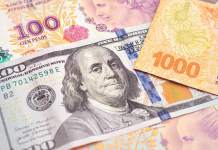Gold ETF Investment Advantages
A Gold ETF – exchange-traded fund – is not the same as investing in physical gold.
Gold ETF’s can be viewed as a hybrid investment that combine paper shares of gold with an ownership stake in bullion, albeit at one remove. That’s because the ETF itself holds gold as its underlying asset, and as a shareholder in the ETF, you own a share of that gold.
For many investors, buying shares in a gold ETF will be the path of least resistance, the easiest way to profit from gold’s rise. ETFs have a lot of advantages. They trade like stocks, making them easy to buy and sell. Commissions are low. You don’t need to hassle with storage and insurance.
The most actively traded gold ETFs in the U.S. are SPDR Gold Shares, which trades under the symbol GLD, and iShares Gold Trust, with the symbol IAU. GLD is bigger and has a slightly higher expense ratio – 0.4 percent compared to 0.25 percent for IAU. The lower expense ratio does translate into marginally better returns for IAU. On the other hand, GLD’s larger size might help it better survive any sort of crisis – malfeasance, fraud, theft – justifying the higher expense ratio.
Gold ETF Notable Disadvantages
I think a gold ETF is a reasonable way to invest in the metal and participate in its gains. But again, it doesn’t have the same level of barricade-the-doors certainty as physical gold. If anything did go wrong with an ETF you’ve invested in, you’d likely be out of luck. As a shareholder, your right to the company’s assets, i.e. its gold holdings, would come after other creditors. It’s not something I expect, but it’s always good not to walk into investments blindly.
And again, the chance that something could go wrong with an ETF, though a black swan, is still something that could happen. Moreover, if an ETF did bite the dust, it could be a result of some sort of massive, economy-wide liquidity crisis. Since one reason to invest in gold is to protect yourself against major negative events, that would be galling, to say the least.
Beware of Investing on Margin
One aspect of ETFs that might intrigue some investors is that they can be purchased on margin, leveraging their bet on gold. With margin, you can invest as little as 50 percent of the ETF’s value and double your gains if gold goes up. Of course, if gold goes down, you’ll double your losses. In any case, you’ll pay interest on margin.
Although I believe gold is headed higher, I don’t recommend buying it on margin, which is a strategy best left to professional traders. In this type of situation, I think it pays to listen to Warren Buffett. I once heard Warren Buffett advise investors not to buy his stock, Berkshire Hathaway, on margin. Despite Berkshire’s extraordinary past success, and Buffett’s confidence in the company’s long-term prospects, he knew there were times when Berkshire declined as much as 50 percent from a previous high.
If you had owned Berkshire on margin during one of those declines, you probably would have lost your entire investment and then some, since brokerage houses insist that investors, for safety reasons, continue to add to their investment as the stock drops.
Even more galling, you might have been wiped out just at the moment you could have jumped on a great buying opportunity. One of the declines came toward the end of the wild early 1999-early 2000 bull market in tech stocks. In the wake of that crash, Berkshire soared.
The second 50 percent decline in Berkshire occurred during the 2008-09 bear market. Again, a fully margined investor would have lost out on a major comeback.
Ironically, given gold’s reputation for volatility, in the past 20 years there are no instances of gold ever declining as much as 50 percent from its high. Moreover, if you trace gold’s record from the first 50 percent decline in Berkshire, you’ll find that gold outperformed Berkshire by about 80 percentage points.
But I still wouldn’t take that as a green light to buy gold on margin. My view on gold is that it is headed higher, indeed dramatically higher, because of a seismic shift in the world’s financial underpinnings. I don’t expect this to lead to a major collapse in financial institutions, including ones that offer ETFs. But I don’t see any reason to take unnecessary chances when you can make so much money in gold just by playing it safe.
A Gold Investment to Shun
That brings me to another vehicle for investing in gold: ETNs, or exchange-traded notes. On the surface they might seem appealing. But I would stay away from them.
While ETFs invest in bullion, ETNs create “paper” gold by positioning investments in futures or other trading vehicles so that they faithfully follow the price of physical gold. The reason they might seem tempting is that they seemingly offer the chance to double or triple your gains (and of course your losses). But as an investment based on derivatives, there is always the risk that something will go wrong even if the underlying financial instrument – in this case, gold – performs as expected. With ETNs, there’s the added problem that when gold is volatile, they can misfire badly.
A case in point is the DB Gold Double long ETN, with the symbol DGP. Its stated aim is to double the gains in gold. But during the stretch of years between June 30, 2013 and early October 2019, when gold ETFs rose more than 19 percent, the ETN rose only a bit over 13 percent. Only when gold then began to decline did its doubling power kick in – it doubled gold’s drop. Don’t go near ETNs.
To sum up, if you are inclined to allocate part of your assets to physical gold, I think that coins, bars that come with the proper certifications, and ETFs will all serve you well. And there’s nothing wrong with having some of each.

















